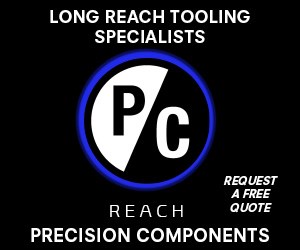Moldmaker Doubles Feed Rates And Improves Finishes With NC Filtering Software
At Tredegar Molded Products (St. Petersburg, Florida), Ron Kalevich and David Lundy were looking for a way to increase feed rates and reduce polishing times for the injection molds they produce. Tredegar is a manufacturer of high precision, multi-cavity injection molds for the packaging industry.
At Tredegar Molded Products (St. Petersburg, Florida), Ron Kalevich and David Lundy were looking for a way to increase feed rates and reduce polishing times for the injection molds they produce. Tredegar is a manufacturer of high precision, multi-cavity injection molds for the packaging industry.
Mr. Lundy found that their machine tools were cutting below normal feed rates due to data starvation at the controls. This was occurring when the G1 linear moves generated by their CAM system were so close together that the control could not process the next move before the current move was completed. The machine would pause at each point, waiting for the control to catch up. With hundreds of thousands of points needed to define a molded cavity, this problem doubled the projected cutting time for their molds.
Another problem caused by the linear move approximation of their surfaces was poor surface finish. A machined mold could take up to 200 hours to polish to customer specifications. If the complex surfaces could be cut using arc motions instead of small linear motions, the finish would be significantly better right off the machine.
One possible solution Tredegar considered would be to customize their controls with high speed readers, but the cost was over $10,000 per control, and it would not address the finish problem. Another possible solution would be to purchase a new CAM system which would output arc moves for surface machining, which would eliminate the data starvation and greatly improve the surface finish. A new CAM system that could do this would cost over $20,000.
Mr. Kalevich came across a third and less costly solution to the problem; a less expensive software package which could convert his existing surface programs from linear moves into arc moves. The package, FilterMAX NC code optimizer from Machine Shop Solutions in Bald Cynwyd, Pennsylvania, converts the small linear moves of an NC surface program into tangent G2/G3 arc moves by fitting arcs through the existing data points in the NC file.
The arc moves generated by FilterMAX more accurately approximate surfaces, with chordal deviation and tangency tolerances controlled by the user. Tredegar typically holds tolerances of 0.0005 on their molds with the FilterMAX optimized programs, and their NC files are reduced up to 99 percent, as the thousands of linear moves are replaced by a smaller number of arcs.
In order for most CNC's to use arc motion, the arcs must lie in one of the three principal planes (XY, XZ, YZ). Tredegar's practice of utilizing constant Z-level and raster (XZ, YZ) machining made tangent arc tool paths a logical next step.
A cost study performed by Tredegar showed that implementing FilterMAX has saved a significant amount of money and benefited them in several ways: machining speeds are doubled, saving hundreds of hours of machining time per year; polishing times are cut in half, saving up to 100 hours per mold set; smaller NC files are easier to manage; machines operates smoother using arc motions, with less wear and tear on machine; tool life increased by over 30 percent due to smoother cutting and constant feed rates.
Mr. Lundy says, "We are very pleased with it. The software paid for itself on the very first job." MMS
Related Content
6 Machine Shop Essentials to Stay Competitive
If you want to streamline production and be competitive in the industry, you will need far more than a standard three-axis CNC mill or two-axis CNC lathe and a few measuring tools.
Read MoreFearless Five-Axis Programming Fosters Shop Growth
Reinvestment in automation has spurred KCS Advanced Machining Service’s growth from prototyping to low-and mid-volume parts. The key to its success? A young staff of talented programmers.
Read MoreWhen Handing Down the Family Machine Shop is as Complex as a Swiss-Turned Part
The transition into Swiss-type machining at Deking Screw Products required more than just a shift in production operations. It required a new mindset and a new way of running the family-owned business. Hardest of all, it required that one generation let go, and allow a new one to step in.
Read MoreGenerating a Digital Twin in the CNC
New control technology captures critical data about a machining process and uses it to create a 3D graphical representation of the finished workpiece. This new type of digital twin helps relate machining results to machine performance, leading to better decisions on the shop floor.
Read MoreRead Next
The Automation Event for CNC Machine Shops
Get sensible, real-world automation solutions during this half-day workshop co-located with IMTS 2024.
Read MoreSpindleSHOT Offers Improved Chip Control and Less Maintenance
High-pressure coolant system is customizable to meet customer needs.
Read MoreA History of Precision: The Invention and Evolution of Swiss-Style Machining
In the late 1800s, a new technology — Swiss-type machines — emerged to serve Switzerland’s growing watchmaking industry. Today, Swiss-machined parts are ubiquitous, and there’s a good reason for that: No other machining technology can produce tiny, complex components more efficiently or at higher quality.
Read More

























